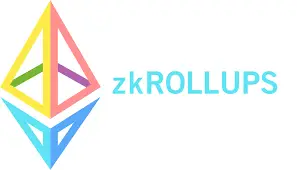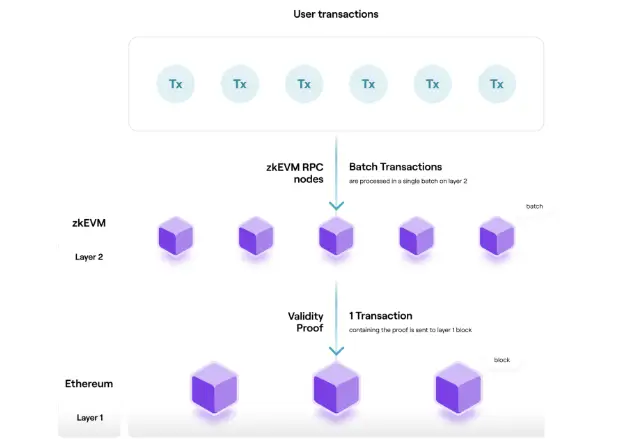Back
Zero-knowledge rollup
Linea
By HackQuest
Jun 3,20246 min readWelcome to the Web3 world, where digital finance and applications are shown in a revolutionary way through the fusion of blockchain technology, cryptocurrencies, and a pioneering spirit. Are you overwhelmed by the wealth of terms in the Web3 world that you don’t understand? Are those slangs barriers for you to learn about Web3? Don’t worry! We’re here to explain the obscure terms to guide your learning. Today, we're diving into an exciting development in the world of Web3: [Zero-knowledge rollup].
Overview

Zero-knowledge rollups (ZK-rollups) aggregate transactions into groups that are processed off-chain. This approach reduces the volume of data that needs to be recorded on the blockchain. Instead of transmitting each transaction separately, ZK-rollup operators provide a summarized update that encapsulates all the transactions in a batch. Additionally, they generate validity proofs to confirm the accuracy of these updates.
The state of a ZK-rollup is managed by a smart contract on the Ethereum network. To update this state, ZK-rollup nodes are required to submit a validity proof for verification. This proof serves as cryptographic evidence that the state changes proposed by the rollup are the actual results of processing the specified batch of transactions. Therefore, ZK-rollups can complete transactions on Ethereum by simply providing validity proofs, rather than uploading complete transaction data on-chain as is necessary with optimistic rollups.
How Does It Work
ZK-rollups enhance scalability by reducing the necessity to post all transaction data on-chain. Instead, they periodically submit validated batches of transactions that have been processed off-chain. These transaction batches are compiled into a single summary of state changes, which is then verified on the base layer through a validity proof. This proof utilizes zero-knowledge technology to mathematically confirm the accuracy of the proposed state changes, ensuring that these modifications are indeed the result of the processed transaction batch.
ZK-rollups typically depend on the base layer for aspects such as data availability, settlement, and resistance to censorship. The state of the rollup is controlled by a smart contract on the L1 network. When users initiate transactions on the rollup, these are generally sent to a L2 operator who includes them in the upcoming transaction batch. This operator, often a centralized figure known as a sequencer, is responsible for executing transactions, organizing them into batches, and forwarding these batches to the L1 network. Alternatively, ZK-rollups may employ a proof-of-stake mechanism, where the responsibility of processing and bundling transactions rotates among a group of validators who have staked funds in a rollup staking contract.
ZK-rollups are considered "hybrid scaling solutions" because they function off-chain while leveraging the security infrastructure of Ethereum. Essentially, the Ethereum network validates the state updates of the ZK-rollup and ensures that the data supporting each update is available. This makes ZK-rollups significantly more secure than solely off-chain solutions like sidechains, which manage their own security, or validiums, which, although they validate transactions on Ethereum using validity proofs, store their transaction data externally.
Zk-Rollup vs. Optimistic Rollup

Comparing to optimistic rollups, ZK-rollups face challenges in achieving compatibility with the Ethereum Virtual Machine (EVM). Demonstrating general-purpose EVM computations in circuits is a more complex and demanding task than verifying simpler computations, such as token transfers mentioned earlier.
Optimistic rollups rely on a fraud proof system that permits any user to contest the results of an optimistic rollup execution within a designated timeframe. Unlike zk-rollups, which cryptographically verify the validity of state changes, optimistic rollups operate under the assumption that transactions are valid unless proven otherwise. This leads to the use of a challenge period post-batch submission on the base layer during which anyone can challenge a rollup transaction by producing a fraud proof. If the fraud proof is valid, the transaction is re-executed and the rollup's state is updated accordingly. If no challenges are made by the end of the challenge period, the transaction batch is considered valid and confirmed on layer 1.
Additionally, the fraud proof mechanism necessitates a waiting period for withdrawing funds from an optimistic rollup to layer 1, typically around seven days from the submission to availability on the base chain. To enhance user experience and reduce waiting times, optimistic rollups might engage liquidity providers who offer quicker withdrawals for a fee. These rollups also make use of economic incentives and game-theoretic strategies to prevent the abuse of fraud proofs and network spam.
Despite the early adoption of optimistic rollups due to their simpler technology and lower risk of bugs, proponents of zk-rollups view them as a superior long-term scalability solution. This is because zk-rollups use cryptographically secure validity proofs to ensure transaction legitimacy.
Pros and Cons
Pros
1.Validity proofs verify the accuracy of off-chain transactions and block operators from making unauthorized state changes.
2.Transaction finality is quicker because state updates are confirmed after validity proofs are checked on Layer 1 (L1).
3.Security is based on trustless cryptographic methods, rather than relying on the integrity of incentivized participants, unlike optimistic rollups.
4.Essential data needed to restore the off-chain state is stored on L1, ensuring security, resistance to censorship, and decentralization.
5.Users enjoy improved capital efficiency and the ability to promptly withdraw funds from Layer 2 (L2).
6.The system operates independently of liveness assumptions, and users are not required to actively validate the chain to safeguard their assets.
7.Enhanced data compression techniques lower the costs associated with posting call data on Ethereum, reducing fees for rollup users.

Source: Medium
Cons
1.The costs involved in computing and validating validity proofs are high and may lead to increased fees for users.
2.Developing EVM-compatible ZK-rollups is challenging due to the complex nature of zero-knowledge technology.
3.The need for specialized hardware to produce validity proofs could lead to centralized control by a limited number of entities.
4.Centralized operators, or sequencers, have the power to affect the sequence of transactions.
5.Hardware requirements could limit the number of participants able to sustain the chain's operation, raising the risk of malicious operators compromising the rollup's state or engaging in censorship.
6.Certain proof systems, such as ZK-SNARK, necessitate a trusted setup that, if improperly handled, could jeopardize the security framework of the ZK-rollup.
Conclusion
In the evolving landscape of Web3, zero-knowledge rollups (ZK-rollups) present a significant advancement, offering a scalable and secure method for processing transactions off the main blockchain. By bundling multiple transactions into a single batch and validating them through cryptographic proofs, ZK-rollups efficiently manage data while ensuring transaction integrity and finality on Ethereum. This mechanism not only enhances scalability but also reduces the on-chain load, maintaining Ethereum's performance and user experience.
ZK-rollups balance the needs for security, efficiency, and decentralization by storing essential transaction data on the base layer, which enables seamless recoveries and consistent state verifications without the complete exposure of transaction details. This method stands out for its ability to offer immediate transaction finality and for reducing potential vulnerabilities associated with relying on external validators.
While ZK-rollups bring many benefits, they also face challenges such as high computational costs and the complexity of developing EVM-compatible solutions. Despite these hurdles, their ability to execute transactions without requiring extensive validation or the risk of fraud places them as a preferable option for long-term scalability solutions in the blockchain space. As the technology matures and overcomes current limitations, ZK-rollups are poised to play a pivotal role in the future of decentralized finance and blockchain applications, promising a more scalable, secure, and efficient framework for handling transactions across various networks.